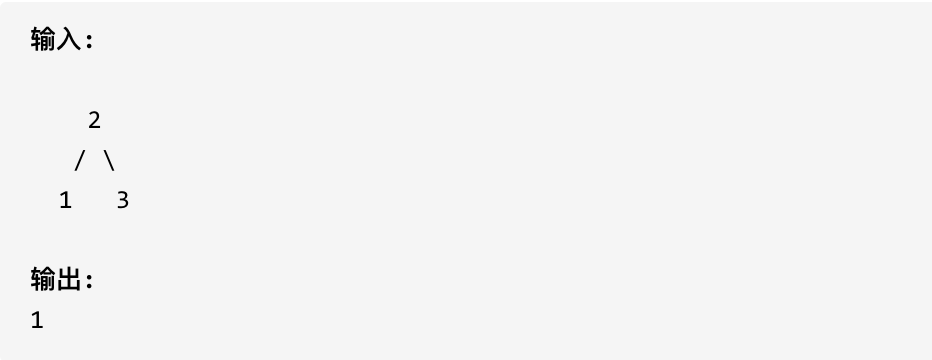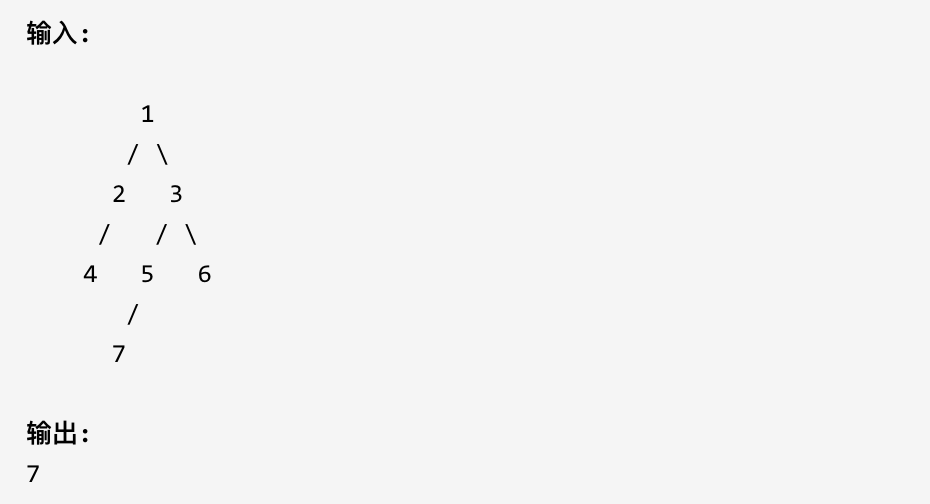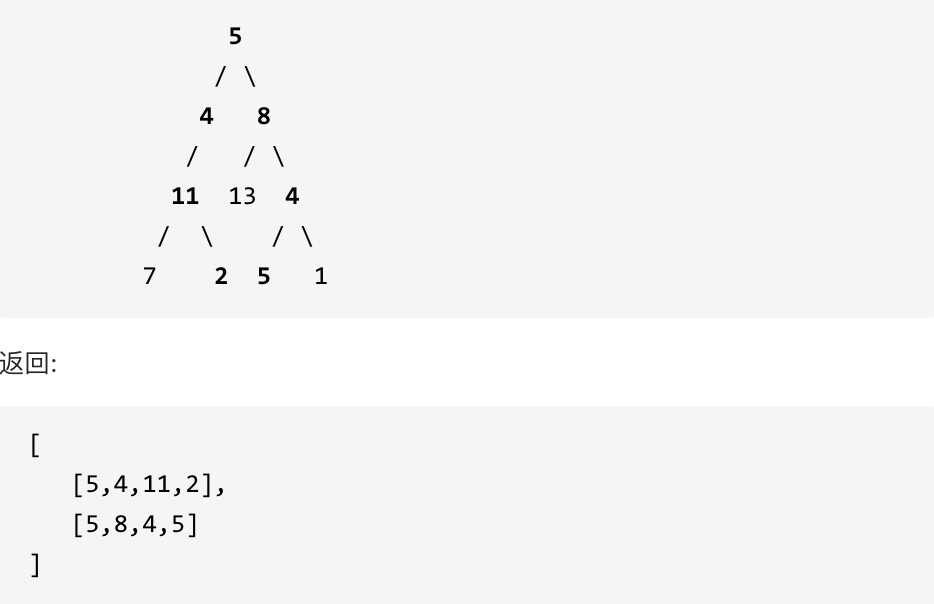目录
一、513.找树左下角的值
给定一个二叉树,在树的最后一行找到最左边的值。
示例 1:

示例 2:

思路
本题要找出树的最后一行的最左边的值。用层序遍历是非常简单的了,反而用递归的话会比较难一点。
本题使用层序遍历再合适不过了,只需要记录最后一行第一个节点的数值就可以了。
//迭代法
class Solution {
public int findBottomLeftValue(TreeNode root) {
Queue<TreeNode> queue = new LinkedList<>();
queue.offer(root);
int res = 0;
while (!queue.isEmpty()) {
int size = queue.size();
for (int i = 0; i < size; i++) {
TreeNode poll = queue.poll();
if (i == 0) {
res = poll.val;
}
if (poll.left != null) {
queue.offer(poll.left);
}
if (poll.right != null) {
queue.offer(poll.right);
}
}
}
return res;
}
}// 递归法
class Solution {
private int Deep = -1;
private int value = 0;
public int findBottomLeftValue(TreeNode root) {
value = root.val;
findLeftValue(root,0);
return value;
}
private void findLeftValue (TreeNode root,int deep) {
if (root == null) return;
if (root.left == null && root.right == null) {
if (deep > Deep) {
value = root.val;
Deep = deep;
}
}
if (root.left != null) findLeftValue(root.left,deep + 1);
if (root.right != null) findLeftValue(root.right,deep + 1);
}
}
二、112. 路径总和
给定一个二叉树和一个目标和,判断该树中是否存在根节点到叶子节点的路径,这条路径上所有节点值相加等于目标和。
说明: 叶子节点是指没有子节点的节点。
示例: 给定如下二叉树,以及目标和 sum = 22,

返回 true, 因为存在目标和为 22 的根节点到叶子节点的路径 5->4->11->2。
思路
可以使用深度优先遍历的方式(本题前中后序都可以,无所谓,因为中节点也没有处理逻辑)来遍历二叉树
1.确定递归函数的参数和返回类型
参数:需要二叉树的根节点,还需要一个计数器,这个计数器用来计算二叉树的一条边之和是否正好是目标和,计数器为int型。
再来看返回值,递归函数什么时候需要返回值?什么时候不需要返回值?这里总结如下三点:
- 如果需要搜索整棵二叉树且不用处理递归返回值,递归函数就不要返回值。(这种情况就是本文下半部分介绍的113.路径总和ii)
- 如果需要搜索整棵二叉树且需要处理递归返回值,递归函数就需要返回值。 (这种情况我们在236. 二叉树的最近公共祖先 (opens new window)中介绍)
- 如果要搜索其中一条符合条件的路径,那么递归一定需要返回值,因为遇到符合条件的路径了就要及时返回。(本题的情况)
遍历的路线,并不要遍历整棵树,所以递归函数需要返回值,可以用bool类型表示。
2.确定终止条件
首先计数器如何统计这一条路径的和呢?
不要去累加然后判断是否等于目标和,那么代码比较麻烦,可以用递减,让计数器count初始为目标和,然后每次减去遍历路径节点上的数值。
如果最后count == 0,同时到了叶子节点的话,说明找到了目标和。
如果遍历到了叶子节点,count不为0,就是没找到。
3.确定单层递归的逻辑
因为终止条件是判断叶子节点,所以递归的过程中就不要让空节点进入递归了。
递归函数是有返回值的,如果递归函数返回true,说明找到了合适的路径,应该立刻返回。
class solution {
public boolean haspathsum(treenode root, int targetsum) {
if (root == null) {
return false;
}
targetsum -= root.val;
// 叶子结点
if (root.left == null && root.right == null) {
return targetsum == 0;
}
if (root.left != null) {
boolean left = haspathsum(root.left, targetsum);
if (left) { // 已经找到
return true;
}
}
if (root.right != null) {
boolean right = haspathsum(root.right, targetsum);
if (right) { // 已经找到
return true;
}
}
return false;
}
}
// lc112 简洁方法
class solution {
public boolean haspathsum(treenode root, int targetsum) {
if (root == null) return false; // 为空退出
// 叶子节点判断是否符合
if (root.left == null && root.right == null) return root.val == targetsum;
// 求两侧分支的路径和
return haspathsum(root.left, targetsum - root.val) || haspathsum(root.right, targetsum - root.val);
}
}三、113. 路径总和ii
给定一个二叉树和一个目标和,找到所有从根节点到叶子节点路径总和等于给定目标和的路径。
说明: 叶子节点是指没有子节点的节点。
示例: 给定如下二叉树,以及目标和 sum = 22,

思路
113.路径总和ii要遍历整个树,找到所有路径,所以递归函数不要返回值!
class Solution {
List<List<Integer>> result;
LinkedList<Integer> path;
public List<List<Integer>> pathSum (TreeNode root,int targetSum) {
result = new LinkedList<>();
path = new LinkedList<>();
travesal(root, targetSum);
return result;
}
private void travesal(TreeNode root, int count) {
if (root == null) return;
path.offer(root.val);
count -= root.val;
if (root.left == null && root.right == null && count == 0) {
result.add(new LinkedList<>(path));
}
travesal(root.left, count);
travesal(root.right, count);
path.removeLast(); // 回溯
}
}四、106.从中序与后序遍历序列构造二叉树
根据一棵树的中序遍历与后序遍历构造二叉树。
注意: 你可以假设树中没有重复的元素。
例如,给出
- 中序遍历 inorder = [9,3,15,20,7]
- 后序遍历 postorder = [9,15,7,20,3] 返回如下的二叉树:

思路
以 后序数组的最后一个元素为切割点,先切中序数组,根据中序数组,反过来再切后序数组。一层一层切下去,每次后序数组最后一个元素就是节点元素。
说到一层一层切割,就应该想到了递归。
来看一下一共分几步:
-
第一步:如果数组大小为零的话,说明是空节点了。
-
第二步:如果不为空,那么取后序数组最后一个元素作为节点元素。
-
第三步:找到后序数组最后一个元素在中序数组的位置,作为切割点
-
第四步:切割中序数组,切成中序左数组和中序右数组 (顺序别搞反了,一定是先切中序数组)
-
第五步:切割后序数组,切成后序左数组和后序右数组
-
第六步:递归处理左区间和右区间
难点大家应该发现了,就是如何切割,以及边界值找不好很容易乱套。
此时应该注意确定切割的标准,是左闭右开,还有左开右闭,还是左闭右闭,这个就是不变量,要在递归中保持这个不变量。
class Solution {
public TreeNode buildTree(int[] inorder, int[] postorder) {
if(postorder.length == 0 || inorder.length == 0)
return null;
return buildHelper(inorder, 0, inorder.length, postorder, 0, postorder.length);
}
private TreeNode buildHelper(int[] inorder, int inorderStart, int inorderEnd, int[] postorder, int postorderStart, int postorderEnd){
if(postorderStart == postorderEnd)
return null;
int rootVal = postorder[postorderEnd - 1];
TreeNode root = new TreeNode(rootVal);
int middleIndex;
for (middleIndex = inorderStart; middleIndex < inorderEnd; middleIndex++){
if(inorder[middleIndex] == rootVal)
break;
}
int leftInorderStart = inorderStart;
int leftInorderEnd = middleIndex;
int rightInorderStart = middleIndex + 1;
int rightInorderEnd = inorderEnd;
int leftPostorderStart = postorderStart;
int leftPostorderEnd = postorderStart + (middleIndex - inorderStart);
int rightPostorderStart = leftPostorderEnd;
int rightPostorderEnd = postorderEnd - 1;
root.left = buildHelper(inorder, leftInorderStart, leftInorderEnd, postorder, leftPostorderStart, leftPostorderEnd);
root.right = buildHelper(inorder, rightInorderStart, rightInorderEnd, postorder, rightPostorderStart, rightPostorderEnd);
return root;
}
}class Solution {
Map<Integer, Integer> map; // 方便根据数值查找位置
public TreeNode buildTree(int[] inorder, int[] postorder) {
map = new HashMap<>();
for (int i = 0; i < inorder.length; i++) { // 用map保存中序序列的数值对应位置
map.put(inorder[i], i);
}
return findNode(inorder, 0, inorder.length, postorder,0, postorder.length); // 前闭后开
}
public TreeNode findNode(int[] inorder, int inBegin, int inEnd, int[] postorder, int postBegin, int postEnd) {
// 参数里的范围都是前闭后开
if (inBegin >= inEnd || postBegin >= postEnd) { // 不满足左闭右开,说明没有元素,返回空树
return null;
}
int rootIndex = map.get(postorder[postEnd - 1]); // 找到后序遍历的最后一个元素在中序遍历中的位置
TreeNode root = new TreeNode(inorder[rootIndex]); // 构造结点
int lenOfLeft = rootIndex - inBegin; // 保存中序左子树个数,用来确定后序数列的个数
root.left = findNode(inorder, inBegin, rootIndex,
postorder, postBegin, postBegin + lenOfLeft);
root.right = findNode(inorder, rootIndex + 1, inEnd,
postorder, postBegin + lenOfLeft, postEnd - 1);
return root;
}
}五、105.从前序与中序遍历序列构造二叉树
根据一棵树的前序遍历与中序遍历构造二叉树。
注意: 你可以假设树中没有重复的元素。
例如,给出
前序遍历 preorder = [3,9,20,15,7] 中序遍历 inorder = [9,3,15,20,7] 返回如下的二叉树:

思路
与104一致。
class Solution {
Map<Integer, Integer> map;
public TreeNode buildTree(int[] preorder, int[] inorder) {
map = new HashMap<>();
for (int i = 0; i < inorder.length; i++) { // 用map保存中序序列的数值对应位置
map.put(inorder[i], i);
}
return findNode(preorder, 0, preorder.length, inorder, 0, inorder.length); // 前闭后开
}
public TreeNode findNode(int[] preorder, int preBegin, int preEnd, int[] inorder, int inBegin, int inEnd) {
// 参数里的范围都是前闭后开
if (preBegin >= preEnd || inBegin >= inEnd) { // 不满足左闭右开,说明没有元素,返回空树
return null;
}
int rootIndex = map.get(preorder[preBegin]); // 找到前序遍历的第一个元素在中序遍历中的位置
TreeNode root = new TreeNode(inorder[rootIndex]); // 构造结点
int lenOfLeft = rootIndex - inBegin; // 保存中序左子树个数,用来确定前序数列的个数
root.left = findNode(preorder, preBegin + 1, preBegin + lenOfLeft + 1,
inorder, inBegin, rootIndex);
root.right = findNode(preorder, preBegin + lenOfLeft + 1, preEnd,
inorder, rootIndex + 1, inEnd);
return root;
}
}




















 1018
1018

 被折叠的 条评论
为什么被折叠?
被折叠的 条评论
为什么被折叠?








